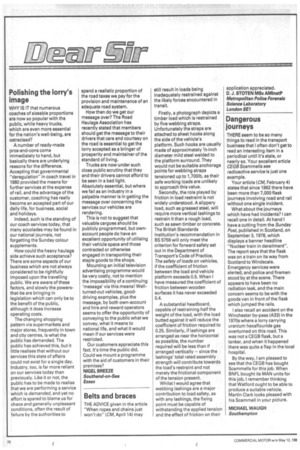Zf T
Page 72

If you've noticed an error in this article please click here to report it so we can fix it.
Polishing the lorry's image
WHY IS IT that numerous coaches of sizeable proportions are now so popular with the public, while heavy trucks, which are even more essential for the nation's well-being, are ostracised?
A number of ready-made pros-and-cons come immediately to hand, but basically there are underlying reasons for the difference. Accepting that governmental "deregulation" in coach travel in 1980 provided the means for further services at the expense of rail, and the advantage of the customer, coaching has really become an accepted part of our daily life, for business, social and holidays.
Indeed, such is the standing of our coach services today, that many accolades may be found in our national journals, not forgetting the Sunday colour supplements.
How could the heavy haulage side achieve such acceptance? There are some aspects of our business which are not always considered to be rightfully imposed upon the travelling public. We are aware of these factors, and slowly the powersthat-be are bringing in legislation which can only be to the benefit of the public, although it does increase operating costs.
The changing shopping pattern via supermarkets and major stores, frequently in town and city centres, is what the public has demanded. The public has achieved this, but it little realises that without our services this state of affairs could not exist for a single day. Industry, too, is far more reliant on our services today than previously. Like it or not, the public has to be made to realise that we are performing a service which is demanded, and yet no effort is spared to blame us for chaos and generally unpleasant conditions, often the result of failure by the authorities to
spend a realistic proportion of the road taxes we pay for the provision and maintenance of an adequate road system, How then do we get our message over? The Road Haulage Association has recently stated that members should get the message to their drivers that care and courtesy on the road is essential to get the lorry accepted as a bringer of prosperity and maintainer of the standard of living.
Trucks are now under such close public scrutiny that they and their drivers cannot afford to be seen in a bad light. Absolutely essential, but where we fail as an industry in a palpable manner is in getting the message over concerning the services our vehicles are rendering.
This is not to suggest that valuable cargoes should be publicly programmed, but ownaccount people do have an excellent opportunity of utilising their vehicle space and those contracted or otherwise engaged in transporting their staple goods to the shops.
Mounting an initial television advertising programme would be very costly, not to mention the impossibility of a continuing 'message' via this means! Wellturned-out vehicles, gooddriving examples, plus the message, by both own-account and hire and reward operators seems to offer the opportunity of conveying to the public what we convey, what it means to national life, and what it would mean if our services were restricted.
Our customers appreciate this fact. It's time the public did. Could we mount a programme with the aid of customers in their premises?
NIGEL BREEZE Southend-on-Sea Essex still result in loads being inadequately restrained against the likely forces encountered in transit.
Firstly, a photograph depicts a timber load which is restrained by five webbing straps. Unfortunately the straps are attached to sheet hooks along the side of the vehicle's platform. Such hooks are usually made of approximately 1/2-inch diameter mild steel welded to the platform surround. They would not be suitable anchorage points for webbing straps tensioned up to 1,7001b, as their safe working loads are unlikely to approach this value.
Secondly, the role played by friction in load restraint is not widely understood. A slippery load, such as greased steel, will require more vertical lashings to restrain it than a rough load, such as sawn timber or concrete. The British Standards Institution's recommendation in BS 5759 will only meet the criterion for forward safety set out in the Department of Transport's Code of Practice, The safety of loads on vehicles, if the coefficient of friction between the load and vehicle platform exceeds 0.5. When I have measured the coefficient of friction between wooden surfaces it has never exceeded 0.4.
A substantial headboard, capable of restraining half the weight of the load, with the load butted against it will reduce the coefficient of friction required to 0.25. Similarly, if lashings are arranged as near the horizontal as possible, the number required will be less than if arranged vertically — since the lashings' total rated assembly strength will contribute towards the load's restraint and not merely the frictional component of the tension present.
Whilst I would agree that webbing lashings are a major contribution to load safety, as with any lashings, the fixing point must be capable of withstanding the applied tension and the effect of friction on their application appreciated. D. J. STOTEN MSc AMInstP Metropolitan Police Forensic Science Laboratory London SE1












































































































